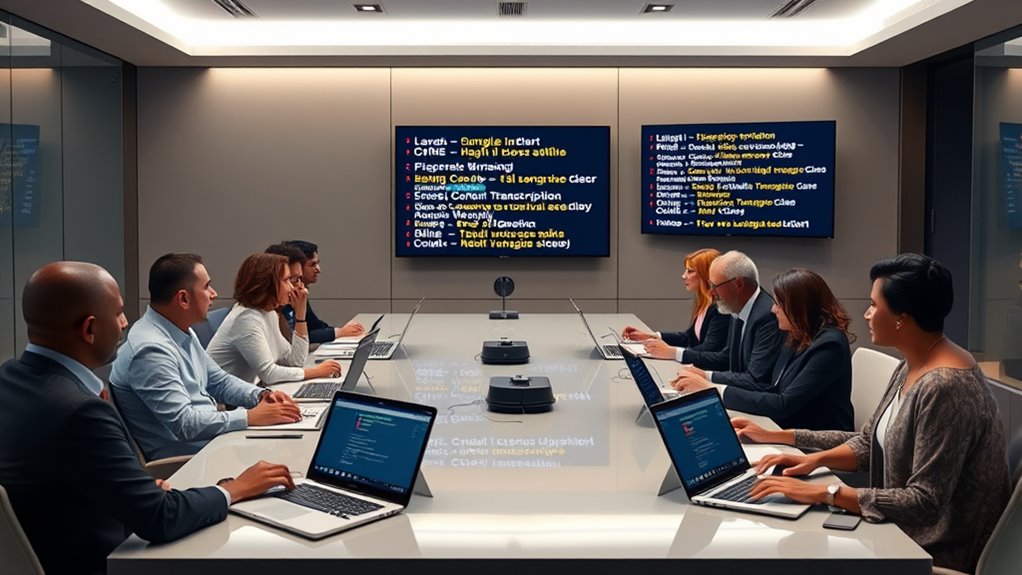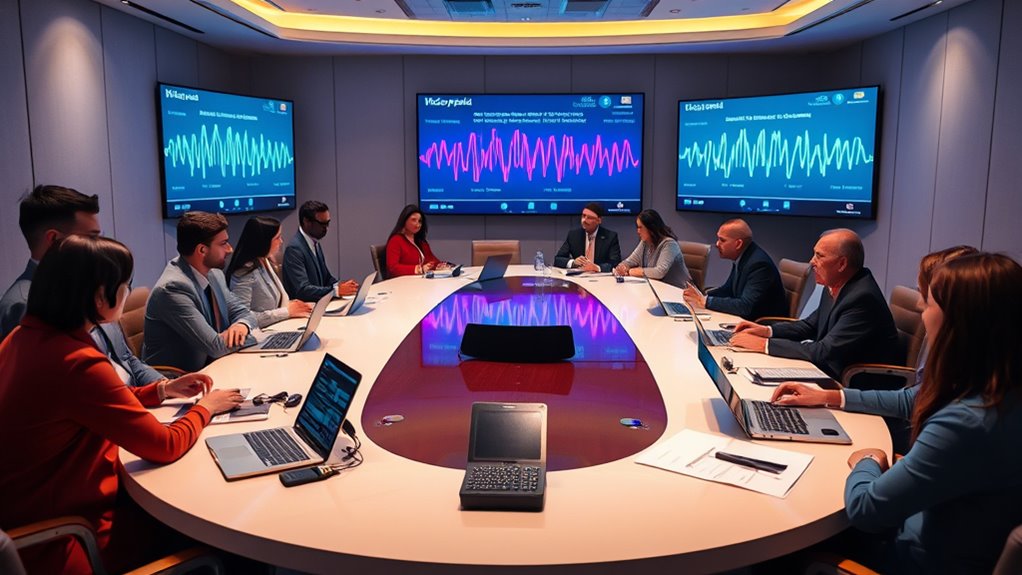In multilingual meetings, live transcription on edge devices offers real-time translation directly on local hardware, reducing delays and protecting your data privacy. This technology avoids reliance on cloud servers, ensuring quick, accurate communication even without internet. It features noise cancellation, multiple language support, and secure encryption, making your cross-language discussions seamless. To maximize effectiveness and security, you’d want to explore key device features and implementation tips—keep going to discover how to optimize your multilingual collaboration.
Key Takeaways
- Edge devices enable real-time, low-latency multilingual transcription without relying on cloud servers or internet connectivity.
- Local processing enhances data privacy and security, protecting sensitive multilingual meeting information.
- Advanced speech recognition and noise-canceling features improve transcription accuracy across multiple languages and dialects.
- Easy device setup and management facilitate seamless integration into existing meeting workflows.
- Future innovations will expand language support, improve AI-powered translation, and embed smart multilingual features into everyday devices.
The Rise of Multilingual Collaboration in Global Business

As companies expand across borders, multilingual collaboration has become essential for effective communication and decision-making. You now work in an environment where teams speak different languages, and seamless understanding is fundamental. Advances in technology make it easier to bridge language gaps, enabling real-time communication without delays. Multilingual meetings foster inclusivity, ensuring everyone’s voice is heard and understood. This technological shift is supported by AI-driven translation, which plays a crucial role in breaking down language barriers. This promotes innovation, faster problem-solving, and stronger relationships among global partners. You no longer rely solely on human interpreters or static translations; instead, live transcription tools allow you to follow conversations effortlessly, regardless of language barriers. As a result, your organization becomes more agile, competitive, and capable of steering through the complexities of international markets. Multilingual collaboration is no longer optional; it’s a critical part of modern global business success.
Challenges in Traditional Language Translation Methods

Traditional language translation methods often struggle to keep pace with the dynamic nature of modern meetings. They typically rely on centralized servers, which introduce delays due to data transmission and processing times. This lag can cause miscommunications, especially when quick exchanges are essential. Additionally, these methods often require significant bandwidth and powerful hardware, making real-time translation difficult in low-connectivity environments. They also depend heavily on pre-trained models that may not adapt well to idiomatic expressions or context-specific nuances. As a result, translations can be inaccurate or awkward, reducing clarity and effectiveness. These limitations hinder effective multilingual communication, especially during live discussions where timing and precision matter most. Overcoming these challenges requires more agile, localized solutions—precisely what edge-based transcription technologies aim to deliver. High refresh rates and low input lag are critical for ensuring smooth, real-time interactions in such systems.
Advantages of Edge-Based Live Transcription Technology

Edge-based live transcription reduces delays, so you get real-time translations without lag. It also keeps your data private by processing information locally, rather than sending it to external servers. Plus, it works offline, ensuring reliable communication even without internet access. Additionally, incorporating secure data practices helps protect sensitive information during transcription processes.
Reduced Latency and Delays
Because edge-based live transcription processes data locally on user devices or nearby servers, it substantially reduces the time needed to convert speech into text. This means you experience almost instant feedback during meetings, minimizing frustrating delays. Unlike cloud-based systems that require data to travel over networks, edge devices handle processing immediately, eliminating bottlenecks caused by network latency. As a result, your transcription appears almost in real time, allowing for smoother conversations and quicker responses. Reduced latency also improves the accuracy of live transcriptions, as the system can adapt more swiftly to speech variations. This rapid processing creates a more natural interaction, especially in multilingual meetings where timing and clarity are essential. Additionally, natural language processing capabilities on edge devices enable better understanding of context and nuances during conversations. Overall, edge technology guarantees your communication remains seamless and efficient with minimal delays.
Enhanced Data Privacy
By processing speech data locally, edge-based live transcription considerably enhances your data privacy. Instead of sending sensitive conversations to cloud servers, all transcription occurs directly on the device. This means your confidential discussions stay within your control, reducing the risk of data breaches or unauthorized access. You don’t have to worry about transmitting sensitive information over the internet, which can be vulnerable to hacking or interception. Additionally, local processing minimizes data storage on external servers, aligning with privacy regulations and company policies. This approach makes sure that your meeting details remain private and secure at all times. With edge-based transcription, you gain peace of mind knowing your data is protected without sacrificing the convenience of real-time multilingual transcription. Moreover, it helps mitigate cybersecurity vulnerabilities that can be exacerbated during outages or attacks on cloud infrastructure.
Offline Accessibility and Reliability
Have you ever been in a meeting where internet connectivity suddenly drops, leaving your transcription service useless? Edge-based live transcription offers a solution by functioning offline. Since processing happens directly on the device, you’re not dependent on a stable internet connection. This means your transcription remains accessible and accurate, even in remote locations or unstable networks. You won’t experience delays or interruptions caused by connectivity issues, ensuring seamless communication. Offline reliability also reduces latency, so transcriptions appear in real-time without lag. With edge technology, you gain peace of mind knowing your meeting recordings are consistent and dependable, regardless of external factors. This robustness makes edge-based transcription ideal for critical meetings, confidential discussions, or environments with unreliable internet.
Key Features to Look for in Edge Transcription Devices

When choosing edge transcription devices for multilingual meetings, it’s essential to focus on key features that guarantee accurate and efficient performance. First, look for devices with robust language support, including multiple languages and dialects, to ensure seamless communication. Accuracy is vital, so prioritize devices with advanced speech recognition and noise-canceling capabilities. Speed matters, too—opt for solutions that deliver real-time transcription without lag. Portability and ease of use are important for quick setup and minimal disruption. Additionally, check for data security features, such as encryption, to protect sensitive information. Compatibility with various conferencing platforms and the ability to integrate with existing systems can streamline your workflow. Incorporating AI-powered transcription can further enhance accuracy and responsiveness in multilingual settings. By selecting devices with these key features, you’ll facilitate clearer, more effective multilingual meetings.
Implementing Live Transcription Solutions in Meetings

Implementing live transcription solutions in meetings requires careful planning to guarantee smooth adoption and maximum effectiveness. First, select the right edge device that supports your language needs and integrates seamlessly with your existing conferencing tools. Make certain the device’s setup is straightforward, with minimal technical hurdles. Train your team on how to activate and troubleshoot the system quickly. Establish clear protocols for participants to speak clearly and avoid overlapping dialogue, which can hinder transcription accuracy. Test the system beforehand in a controlled environment to identify and resolve potential issues. Additionally, communicate the benefits and procedures to everyone involved, so they understand how to use the system effectively. Proper planning ensures the technology enhances communication without disrupting the meeting flow. Regularly monitoring market conditions and updating your transcription tools can help maintain accuracy and adapt to evolving language requirements.
Ensuring Privacy and Data Security on Edge Devices

To safeguard sensitive information during multilingual meetings, you need to focus on local data processing so data stays on the device. Implement end-to-end encryption to keep conversations secure from interception, and set up strict access controls to limit who can view or modify data. These measures ensure your meeting data remains private and safe from breaches. Additionally, understanding cultural and regional breakfast traditions can help tailor communication styles and content for diverse international teams.
Local Data Processing
Ensuring privacy and data security on edge devices is essential as more multilingual meeting applications process sensitive information locally. By handling data directly on the device, you reduce the risk of interception or unauthorized access during transmission. You can implement local data processing techniques like on-device speech recognition and language translation, which keep conversations private. This approach minimizes dependence on cloud servers, lowering exposure to cyber threats. You should also utilize secure storage methods, such as encrypted databases, to safeguard stored transcripts and user data. Regular updates and firmware patches are critical to patch vulnerabilities. Additionally, limiting data access to authorized applications and users ensures that sensitive information remains confined within the device. Proper management of necessary cookies and other security measures help maintain privacy standards. Overall, local data processing enhances privacy while maintaining the efficiency of multilingual meeting solutions.
End-to-End Encryption
How can you guarantee that sensitive data remains private during local processing in multilingual meetings? End-to-end encryption (E2EE) ensures that data stays secure from capture to delivery. When you use E2EE on edge devices, the transcription data is encrypted immediately after capture, and only decrypted on authorized endpoints. This prevents unauthorized access during processing or transmission. Here’s a visual breakdown:
| Stage | Security Measure |
|---|---|
| Data Capture | Encrypted on-device |
| Local Processing | Decrypted only within the device |
| Data Transmission | Encrypted via secure channels |
| Decryption on Recipient | Only authorized users can decrypt |
| Storage | Encrypted if saved locally |
This setup guarantees privacy, making sure your sensitive conversations stay protected. Content security is essential for maintaining trust and compliance in multilingual meetings.
Access Control Measures
Implementing robust access control measures is essential for maintaining privacy and securing data on edge devices during multilingual meetings. You need to ensure only authorized users can access sensitive transcription data and device functions. Here are three key measures to consider:
- User Authentication: Use strong methods like multi-factor authentication to verify identities before granting access.
- Role-Based Access Control: Assign permissions based on roles, limiting users to only the data and features they need.
- Encryption and Local Storage Security: Protect stored data with encryption and restrict physical device access to prevent unauthorized tampering.
Case Studies: Successful Deployment of Multilingual Transcription

Have you ever wondered how organizations successfully deploy multilingual transcription to bridge language gaps in meetings? One notable example is a multinational corporation that integrated edge devices with real-time translation capabilities. They installed edge-based transcription systems in conference rooms, enabling seamless communication across diverse teams. The system accurately transcribed and translated conversations into multiple languages instantly, reducing misunderstandings and improving collaboration. Another case involved an international NGO conducting field meetings, where network connectivity was limited. By deploying on-device transcription, they maintained real-time language support without relying on internet access. These deployments demonstrate that with the right technology and strategic implementation, organizations can effectively break down language barriers, foster inclusion, and enhance productivity in multilingual environments.
Future Trends and Innovations in Edge Computing for Language Support

Building on successful multilingual transcription deployments, future innovations in edge computing are poised to revolutionize language support even further. You can expect smarter, more efficient devices that handle complex language tasks locally, reducing reliance on cloud services. These advancements will enable real-time translation and transcription for even less common languages, making global communication seamless. Additionally, privacy will improve as sensitive data stays on the device, minimizing security risks.
Here are three key trends to watch:
- Enhanced AI models optimized for edge devices, offering faster and more accurate translations.
- Increased integration of multilingual capabilities into everyday gadgets like smartphones and wearables.
- Development of adaptive systems that learn and personalize language support based on user behavior and context.
Frequently Asked Questions
How Accurate Is Live Transcription Across Diverse Languages and Accents?
You’re curious about how accurate live transcription is across different languages and accents. Modern transcription tools have improved considerably, leveraging advanced AI and machine learning. They can handle a variety of accents and dialects, but accuracy may still vary depending on the language, speaker clarity, and background noise. Generally, newer systems perform well, but for critical tasks, double-checking or manual review is recommended to guarantee precision.
What Are the Cost Implications of Deploying Edge-Based Transcription Devices?
You’re wondering about the cost of deploying edge-based transcription devices. These devices can be cost-effective over time because they reduce reliance on cloud services, lowering bandwidth and subscription expenses. However, initial setup and hardware costs might be higher. You should consider maintenance, upgrades, and scalability. Overall, while they may require a significant upfront investment, they can save money long-term by streamlining operations and enhancing real-time multilingual communication.
Can These Devices Be Integrated With Existing Conferencing Platforms Seamlessly?
Imagine transforming your meetings effortlessly—you wonder if these edge devices can seamlessly blend with your current conferencing tools. The good news is, yes, they can. With compatible APIs and flexible integration options, you’ll find that connecting them is straightforward. This means you won’t need to overhaul your existing setup, allowing you to enjoy real-time, multilingual transcriptions without missing a beat. Exciting, isn’t it?
How Do Edge Devices Handle Complex Technical or Industry-Specific Terminology?
You might wonder how edge devices manage complex technical or industry-specific terms. They handle this by leveraging advanced AI models trained on specialized vocabularies, ensuring accurate recognition. When encountering unfamiliar jargon, these devices often adapt through continuous learning or user feedback, refining their understanding. This way, you get precise transcriptions, even in specialized fields, making your meetings clearer and more efficient without relying heavily on cloud resources.
What Are the Maintenance and Upgrade Requirements for Edge Transcription Hardware?
You need to regularly check your edge transcription hardware for firmware updates and security patches to guarantee peak performance. Keep an eye on hardware components like storage, memory, and processing units, replacing or upgrading them as needed to handle growing data loads. Schedule routine maintenance to clear caches, verify connections, and troubleshoot issues promptly. Staying proactive with these tasks helps prevent downtime and maintains accurate, real-time transcription during your meetings.
Conclusion
As you explore edge-based live transcription, remember that over 70% of global businesses are now adopting multilingual tools to stay competitive. By leveraging these innovations, you can facilitate seamless communication, boost productivity, and respect privacy. Embracing this technology means you’re not just keeping up—you’re leading the way in inclusive, efficient collaboration. Don’t miss out on transforming your meetings into truly global, secure, and real-time conversations.









